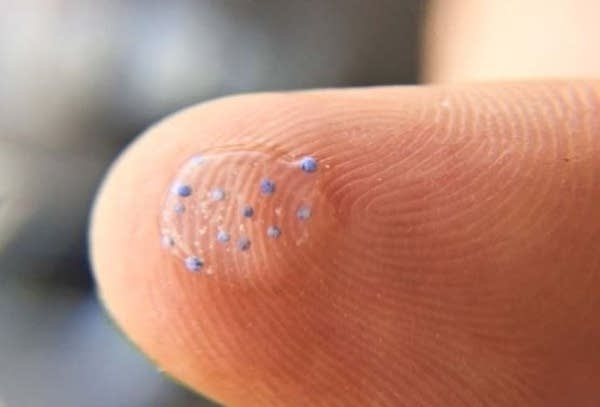Here's what you can do about plastic pollution

It's easy to see plastic pollution every day, whether it's cigarette butts scattered across a bus stop or fast-food trash thrown carelessly on the side of the highway.
But that's just the beginning. Look a little more and you'll find massive piles of trash like the twice-as-big-as-Texas Great Pacific garbage patch, and widespread water pollution by microplastics from clothes, shampoo or soaps.
It's difficult to understate how widespread the pollution is from the 9.1 billion tons of plastic that humans have produced since the material's invention in 1907. A trio of U.S. researchers spell it out in a paper published last year:
• As of 2015, humans worldwide had generated 6.9 billion tons of plastic waste — under 10 percent of which was recycled. Most of it wound up littered or in landfills.
Create a More Connected Minnesota
MPR News is your trusted resource for the news you need. With your support, MPR News brings accessible, courageous journalism and authentic conversation to everyone - free of paywalls and barriers. Your gift makes a difference.
• An estimated 2.8 billion tons of plastic are currently in use. That's about 30 percent of all plastics ever made.
• Only some 9 percent of plastics get recycled.
• Under current conditions, 13.2 billion tons of plastic will be either litter or in landfills by 2050.
However, addressing the issue isn't a hopeless cause, and there are some things individuals can do about it.
As the Earth Day Network notes, "modern technology has created a host of new products that make most common plastic products obsolete."
Swap out plastic products, or stop using them entirely
When a plastic product comes your way, ask yourself: Do I really need this, or can I use something else? Chances are you can say no, and yes.
Some people have committed to a plastic-free lifestyle, so chances are all of us could find ways to at least cut use. Here are a few tips for how individuals can help:
• Drink from reusable vessels. Our planet buys a million plastic bottles every minute. Get a reusable water bottle.
• Use cloth bags. All those trips to the store can add up. Reusable grocery bags are ubiquitous, but did you know you can get smaller reusable produce bags for a plastic-free shopping experience?
• Say no to straws. They just become waste, and you probably don't need one!
• Consider getting your baby cloth diapers. Some 3.4 million tons of diapers wind up in landfills each year from the U.S. alone. Of course, washing cloth diapers takes much energy and water, so it might be a toss up depending where you live whether cloth or disposable diapers are more environmentally friendly.
Clean up waste that's already there
• Use your wallet. Buy only plastic products made from materials that were recycled or recovered from the environment. For example, Jordan, Minn.-based By the Yard makes lawn furniture out of recycled milk jugs. Minneapolis' Scrappy Products uses old, recycled drink bottles to make bags. These are just two examples, and similar companies abound.
• Organize a cleanup. Green Hands USA has a handy template for how to do it. Their guide is focused on beaches, but the general principles apply many places.
• Consider donating to large-scale cleanups. Every effort helps, but massive organizations like the Ocean Cleanup are resourced to take bigger bites out of plastic pollution.
Help reduce microplastics pollution
Microplastics — the tiny (under 5 mm) particles that come from clothing, soaps and other sources — wreak havoc on bodies of water and water treatment plants.

Here's how you can help:
• Buy only facial scrubs, toothpaste and other personal care products made with natural exfoliants, such as oatmeal and salt.
• Buy clothing made of organic or natural materials rather than synthetic fibers. Buy only what you need, and invest in higher-quality items so you don't need to replace them as often.
• Don't wash your clothes as often, especially items made from synthetic fabrics like fleece jackets.
• Invest in a mesh laundry bag designed to capture shedding fibers during the washing cycle, like Guppy Friend sold by Patagonia.
This report includes previous work from MPR News reporter Kirsti Marohn.